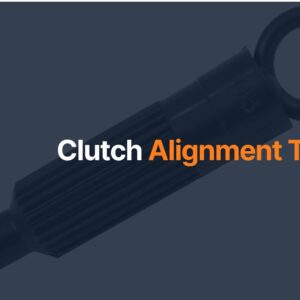If you’ve ever seen a clutch assembly drawing, you’ll notice that your vehicle’s clutch assembly has many different parts. Each of these vital parts has a role to play whenever you engage the clutch to shift gears. Today, we’ll take a look at the clutch assembly’s different parts and what each part does when it’s time for you to shift gears.
Automotive Clutch Assembly Parts

The flywheel is bolted to the crankshaft, and the pressure plate is bolted to the flywheel.
Sandwiched in between the pressure plate and the flywheel is a clutch disk with friction linings and a splined hole in its center that drives the splined transmission input shaft.
When the clutch pedal is pressed, the pressure plate moves slightly away from the engine so that the clutch disk is no longer clamped between the pressure plate and the flywheel. The pilot bearing in the center rear of the crankshaft supports the engine end of the transmission input shaft.
Pilot Bushing or Bearing

The pilot bushing or bearing allows the transmission’s input shaft to remain stationary while the clutch is disengaged and the engine is running.
This part is located in the center of either the flywheel or the crankshaft flange (see drawing), and it can be either a bearing or a bushing. Pilot bearings are ball, needle, or roller bearings packed in grease, while pilot bushings are lubrication-infused brass.
Flywheel
The clutch assembly’s flywheel is bolted to the engine crankshaft and is a large, heavy piece of balanced steel with a machined and polished surface that helps balance the engine. You might notice if you’ve ever removed a flywheel that the bolt holes in the center are staggered so that it will only fit one way. It is carefully balanced to prevent vibration.
Clutch Disc
The clutch engages when the heavy springs in the pressure plate apply clamping force to pinch the friction linings of the clutch disk between the smooth machined surface of the pressure plate and the smoothly machined surface of the flywheel.
The friction linings on both sides of the clutch disk are designed to wear away very slowly like brake pads.
The splined center of the clutch disk drives the matching splined transmission input shaft when the clutch disk is clamped and engaged and the clutch pedal is released.
But when the clutch pedal is pressed, the throwout bearing presses on the center of the pressure plate fingers or diaphragm spring and the heavy surface of the pressure plate lifts away from pinching the clutch disk so that it is no longer driven by the pressure plate-flywheel assembly, which is still spinning at engine speed.
This allows the input shaft to stop driving the transmission between shifts and when sitting still with the clutch pedal pressed and the transmission in gear.
Pressure Plate
As we’ve mentioned, the pressure plate is bolted at its outer edges to the flywheel so that it rotates at the same speed as the flywheel and the engine crankshaft. The pressure plate has a diaphragm spring at its center that releases the pressure on the clutch disc whenever you press the clutch pedal to disengage the clutch.
Release or Throwout Bearing

The clutch release or throwout bearing pushes against the pressure plate’s center diaphragm spring when you press the clutch pedal. This pressure forces the pressure plate away from the clutch disc, which in turn disengages the clutch.
The surface that contacts the pressure plate fingers sits on a bearing so that it can instantly begin to spin as it applies pressure. It will be operated hydraulically or with a fork.
How To Measure Clutch Assembly Replacements
If you’re looking to purchase a clutch disc replacement or other clutch assembly parts, it’s best to double-check that they fit your vehicle’s exact year, make, and model. You can also take the measurements yourself, just to make sure that you’re getting correctly sized parts.
To start, you can measure the clutch disc diameter by measuring across the clutch disc’s face. Take the pressure plate’s diameter by measuring from its backside. Finally, measure the clutch’s bolt pattern by measuring the distance between its bolt holes.
These measurements are helpful for double-checking the proper parts sizes and for working on older vehicles that might not have readily available and labeled parts. Now that you know the basics behind the clutch assembly parts and their functions, you’re better prepared to deal with any clutch assembly issues that might crop up.
Enjoy Fast Delivery of Replacement Clutch Assembly Parts
The clutch assembly relies on the synergy between the clutch disc, flywheel, pinion bearings, pressure plate, and release bearings. If one part develops a problem, the others might follow suit, forcing you to stop driving your car until you can get replacements. Fortunately, CarParts.com quickly delivers new clutch assembly parts to your doorstep.
CarParts.com offers fast delivery of clutch assembly parts such as clutch discs, flywheels, pinion bearings, pressure plates, and release bearings. The distribution center nearest you will handle shipping of on-hand products to save time. If you live in the continental US and send your order before noon ET, you can expect to receive the new parts in several business days. We offer a wide selection of clutch assembly parts exclusively sourced from trusted brands, ensuring you get products you can rely on.
Looking for high-quality clutch assembly parts at competitive prices? Go to CarParts.com and order new clutch discs, flywheels, pinion bearings, pressure plates, or release bearings today!
Any information provided on this Website is for informational purposes only and is not intended to replace consultation with a professional mechanic. The accuracy and timeliness of the information may change from the time of publication.

































